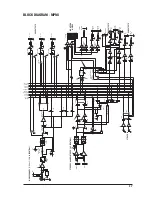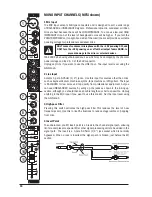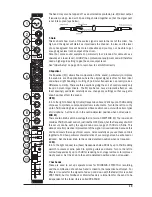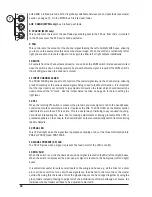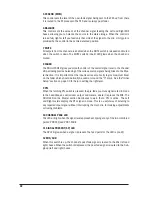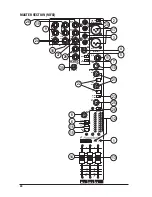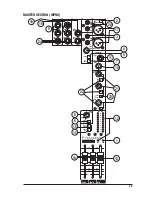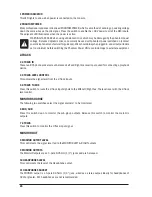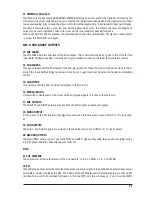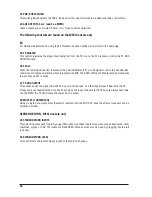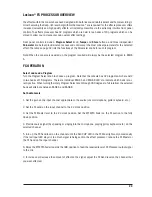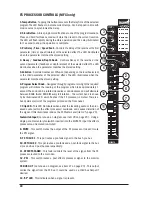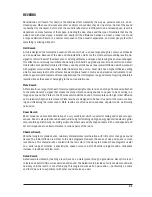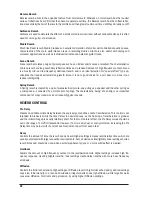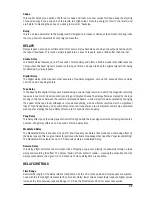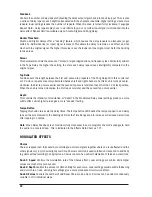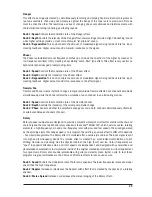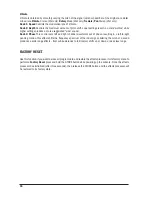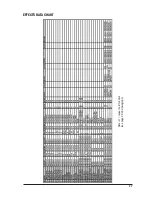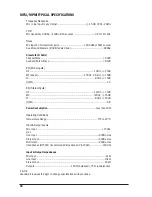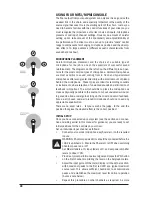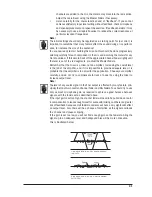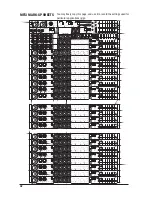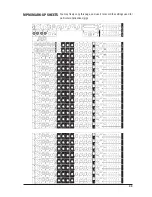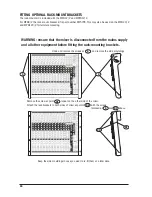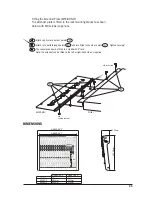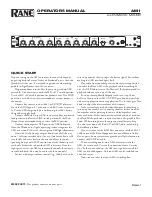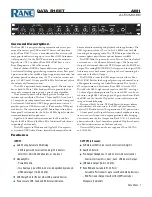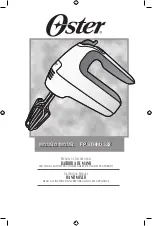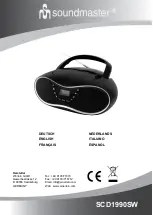
30
FX PROCESSOR CONTROLS (MFXi only)
1. Tempo Button
- Tapping this button twice sets the Delay Time of the selected
program. The LED flashes to indicate current tempo. Can be tapped in time with
music source to synchronise the delay.
2. Store Button
- Stores program modifications to one of the program locations.
Press and hold for three seconds will store the preset in the current location.
The LED will flash rapidly during the store operation and then stay illuminated
for 1 second to show the operation is complete.
3. Pre Delay / Time/ Speed Knob
- Controls Pre Delay of the reverbs or the first
parameter (time or speed related) of the selected effect. The LED illuminates
when the parameter matches the stored setting.
4. Decay / Feedback/Depth Knob
- Controls Decay of the reverbs or the
second parameter (feedback or depth related) of the selected effect. The LED
illuminates when the parameter matches the stored setting.
5. Variation
- Controls Liveliness or Diffusion (depending on the reverb selected)
or the third parameter of the selected effect. The LED illuminates when the
parameter matches the stored setting.
6. Program Select Knob
- Navigates through programs, turning to the required
program will initiate the loading of the program which take approximately 1
second. The knob can be rotated clockwise or anticlockwise and will alternate
between BANK
A
and BANK
B
every full rotation. The current bank is shown
by its illuminated LED, which flashes if the FX processor is muted. There is a
handy aide memoir of the programs printed on the front panel.
7. Clip LED
– This LED illuminates when either the incoming audio or the proc-
essed audio (within the effect processor) overloads, and causes distortion of
the signal. If this illuminates reduce the FX Master Level (item 25, page 20).
Footswitch Input
(not shown on diagram, see item 28 on page 20) - Using a
single pole, momentary footswitch inserted into the MUTE FX input the effects
processor can be muted/un-muted.
8. MUTE
- This switch mutes the output of the FX processor. It doesn’t mute
the PFL signal.
9. FX TO AUX 1
- This pot routes a pre-fade signal to the Aux 1-pre bus.
10. FX TO AUX 2
- This pot routes a pre-fade and a post-fade signal to the Aux
2-pre and Aux 2-post busses respectively.
11. EFFECTS FADER
- This fader controls the level of the signal, from the FX
processor, routed to the main mix.
12. PFL
- This switch routes a post-effects processor signal to the monitor
system.
FX BUS OUT
(not shown on diagram, see item 27 on page 20) - This output
carries the signal from the FX bus. It could be used as a third Aux Output if
desired.
13. ‘SP’ LED
- This indicates when a signal is present.
S.HALL
L.HALL
V.HALL
D.HALL
S.PLT
L.PLT
V.PLT
D.PLT
ROOM
STUDIO
CHMBR
AMB
ARENA
GATED
REV
SPRING
1
2
3
4
5
6
7
8
9
10
11
12
13
14
15
16
S.DLY
D.DLY
T.DLY
P.DLY
M.DLY
R.DLY
CHORUS
FLANGR
PHASR
TREM/P
ROTRY
VIBRTO
RV/DL S
RV/DL L
PHSDEL
ROTDEL
24-BIT DIGITAL
EFFECTS PROCESSOR
A: PRE-DEL
B: TME/SPD
A
B
: VARI
0
10
0
10
PFL
PK
SP
MUTE
FX
BANK A
BANK B
STORE
TEMPO
TAP
BANK A
BANK B
FX TO
AUX1
FX TO
AUX2
A: DECAY
B: FBK/DPTH
EFFECTS
-5
-10
-15
-20
-30
-40
0
3
4
5
7
9
10
11
1
2
6
8
12
13
Summary of Contents for MFXi
Page 1: ...1 USER GUIDE...
Page 23: ...23...
Page 37: ...37 EFFECTS DATA CHART Note H repeat hold function see page 29 2nd paragraph...
Page 39: ...39...
Page 50: ...50 TYPICAL CONNECTING LEADS...


